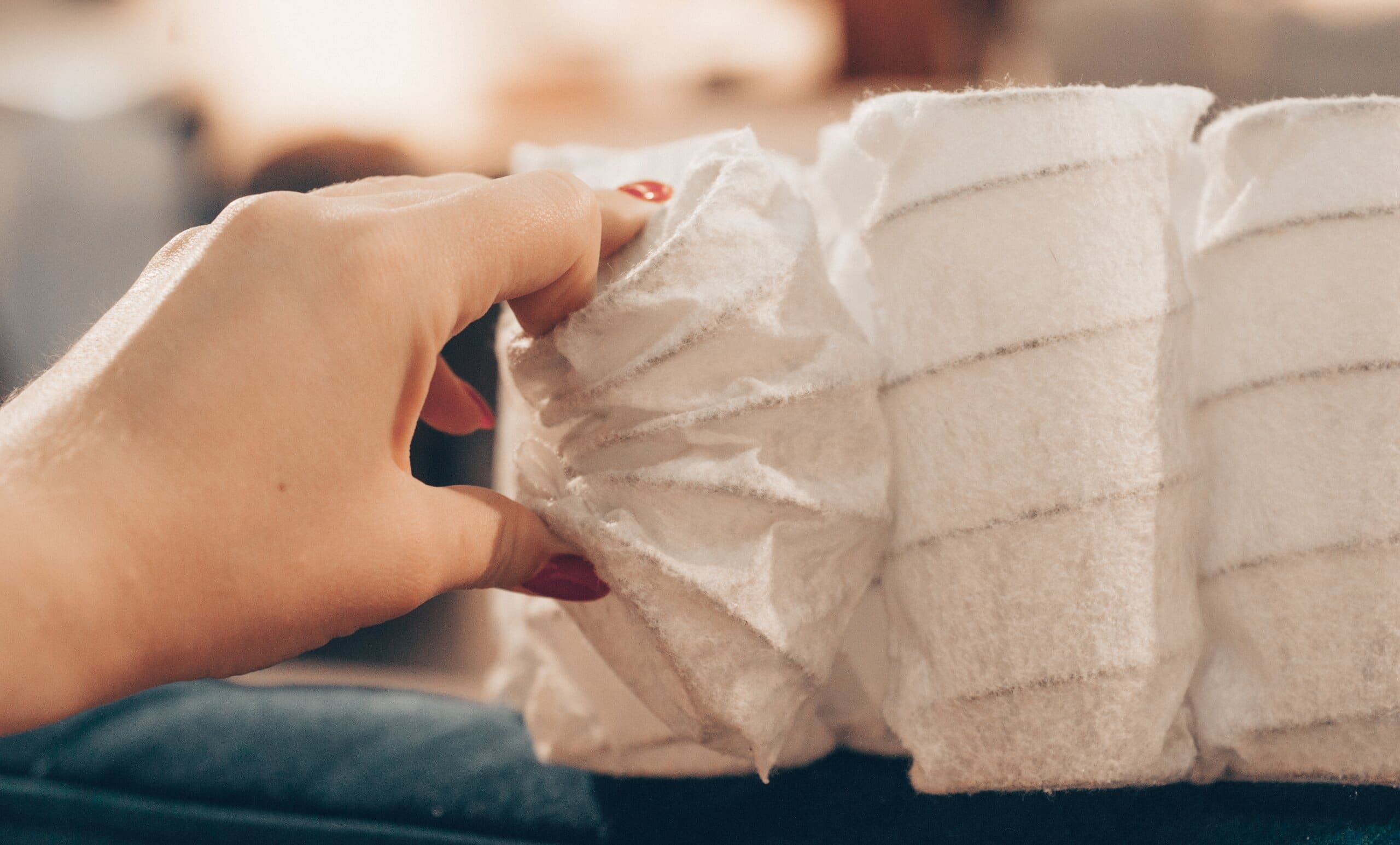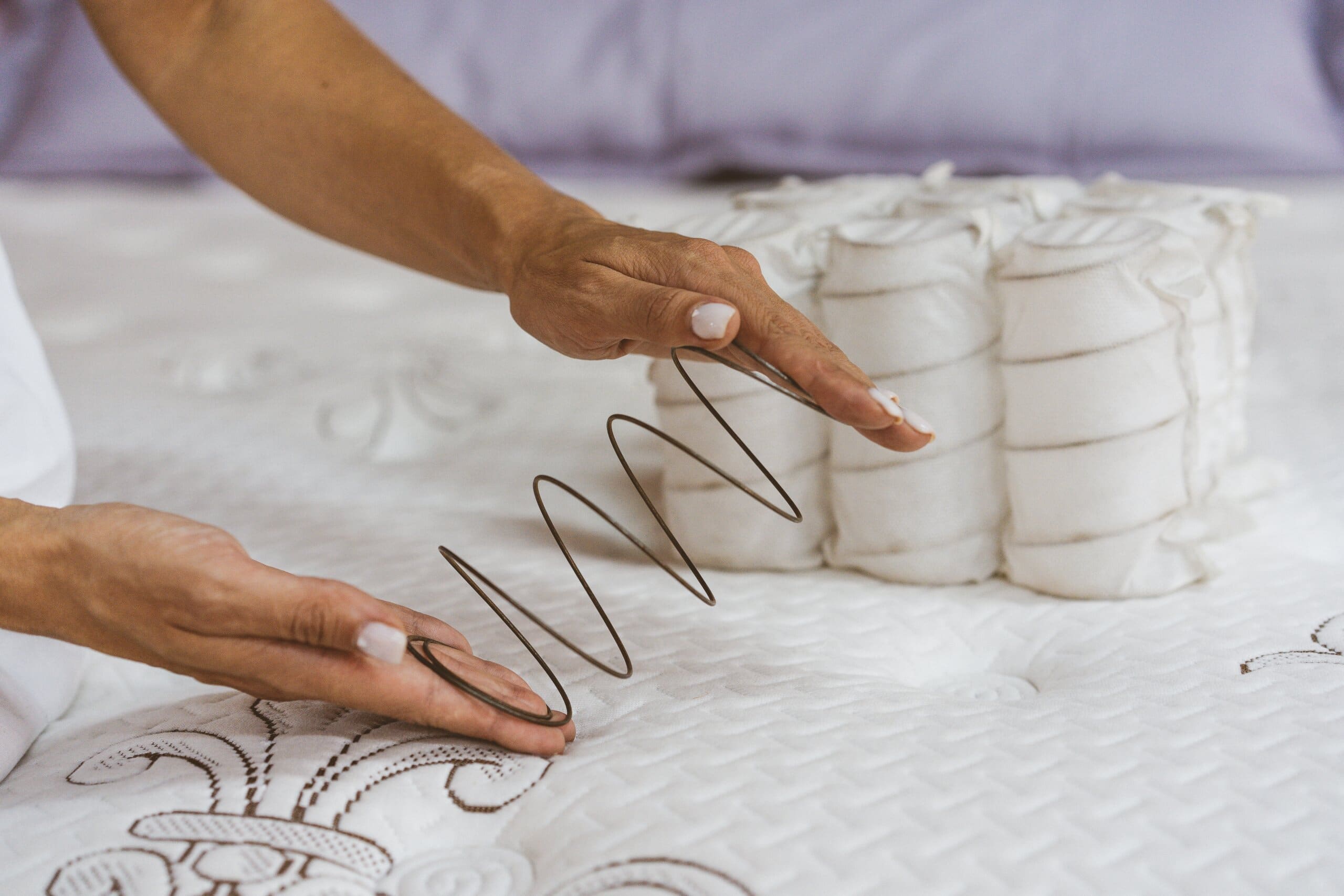Speak to an expert: 0333 0069769
Discover what exactly a pocket spring mattress is, plus how it compares to other mattress types.
One of the most popular types of mattresses available today, pocket sprung mattresses are an updated version of the classic sprung version… but better. In fact, most brands have developed this incredible spring system into the most supportive type of mattress you can buy. Discover exactly how these pocket springs work in our comprehensive guide.

Using high-tensile springs in individual cloth 'pockets', a matrix is created that delivers outstanding comfort and performance. These springs are popular because they work like piano keys, targeting support to your pressure points as you move, and are ideal for back problems. The springs themselves work independently, but react to their neighbours, creating a wave like motion when they feel pressure and adjusting the support they give different parts of your body as you need it.
Each spring reacts to the tension placed on it by body weight and movement. Movement transference is cut down to a minimum as they don't move together, instead reacting to pressure directly where you place it. The springs deliver exceptional support, keeping your spine in a neutral position and banishing aches and pains.
As they support the weight of each partner independently, you both get a restful night's sleep. This is even if one of you is a 'wriggler'! Check out our guide to the top 10 pocket-sprung mattresses of the year to find your next pocket spring mattress.
Pocket sprung mattresses may use traditional manufacturing techniques, but their technology is 21st-century. A combination of materials and production processes creates high-quality mattresses that deliver exceptional comfort all night long.
The key difference between a standard and pocket sprung mattress is the way the springs are put together. A standard sprung mattress, also known as an open coil mattress, consists of an interconnected spring system. This means that the springs all move together as one and provide a degree of contouring support.
The springs in a pocket sprung mattress, however, are sewn into individual fabric pockets. This means that, unlike open coil springs, pocket springs move independently. This helps the mattress to follow and support the contours of your body no matter how you move. Both styles of mattress are great for different reasons.
For instance, standard sprung mattresses tend to be more affordable, allowing you to have comfort on a budget. They also tend to have more ‘give’ than a pocket sprung mattress. For those who prefer a spongy mattress, open coil mattresses are perfect. For more advice on choosing a standard sprung mattress, read our guide to What Is An Open Coil Mattress?
Pocket sprung mattresses are on the firmer side and will outlast a standard sprung mattress since the springs are more resistant. They’re also ideal for couples sharing a bed. Since the springs move independently, you can move freely without worrying about disturbing the other person, avoiding that ‘roll-together’ feeling. Don't worry if you prefer a soft mattress, though, as pocket spring mattresses are often topped with plush layers of comfort materials that can alter the overall feel of the mattress, but still offer incredible support.
Typically, the number of springs in a pocket sprung mattress vary from 1000 to 3000 springs. The amount of springs per mattress will depend on the brand and size of the mattress. For example, all spring counts are based on a king size mattress, so the actual spring count of the same model will vary in a pocket sprung single mattress or super king mattress even though the proportional spring count remains the same.
As a rule of thumb, anything less than 1000 springs can be categorised as lower quality. The quality of anything above will depend on your comfort preferences.
As the number of springs increase in your mattress, so too does the levels of support you receive. Mattresses with high levels of springs are generally thought of as being high in quality and being better for those who suffer from aches and pains.

There are a lot of differences between pocket sprung mattresses and memory foam mattresses, the most obvious being that a memory foam one doesn't have any springs at all!
With a pocket sprung mattress, you're supported by the springs, which hold your body parts up as you sleep. The mattress then restores its shape using the strength of the coils. The springs move independently of one another, so those with no direct weight on them are not compressed.
By contrast, memory foam mattresses are designed to adapt to the shape of the sleeper. The memory foam material is heat responsive - as the foam becomes warm, it is more flexible and moulds itself around the person sleeping.
The foam retains heat, so if you tend to feel hot at night, you may opt for a pocket spring mattress instead. The design of a sprung mattress means that it generally stays cooler than its foam counterpart and is therefore suitable for those who typically overheat at night.
Overall support and comfort levels are another big difference between the two. While memory foam offers contoured and plush pressure-relief, pocket spring mattresses are perfect for those who require highly supportive mattresses which have a firmer feel. Pocket springs hold the body up rather than absorb the weight (like memory foam does), providing strong support.
If you think you'd prefer the 'sink in' feeling a memory foam mattress would offer you rather than the more supportive pocket spring, you can read our Memory Foam Mattress Buying Guide for more information. A hybrid mattress is a great option that combines the benefits of both of these types of mattresses, with a layer of memory foam on top of the reactive pocket springs. Our guide to Pocket-sprung Vs Memory Foam Vs Hybrid: Which Mattress Is Best? will help you decide which of the three will be best for you.
There are some important questions you need to ask yourself when you’re trying to figure out how to choose a pocket sprung mattress for yourself:
Let’s dig a little deeper into these questions and whether a pocket sprung mattress is the right pick for you.
A pocket sprung mattress is an excellent choice if you suffer from joint pains or a bad back. Because it has a reactive spring matrix, micro-adjustments within the core ensure that every part of your body gets the correct amount of support.
Each pocketed spring reacts individually to your movements. So, it supports you continually even if you move around during the night. This works to keep your spine aligned and prevent more aches and pains. If you are struggling with a bad back, read our sleeping tips and guide to the Best Mattresses For Back Pain.
Generally, most pocket sprung mattresses fall into the medium to firm categories. These will provide you with a higher level of support, especially if the spring count is in the 2000 and above range. As we mentioned before, pocket sprung mattresses are often topped with comfort materials like cotton, wool, or even cashmere and silk to alter the feel of the sleep surface.
You can always pair your pocket spring mattress with a firm or soft mattress topper, which is the easiest way to change the feel of your mattress.
Choosing a pocket sprung mattress is a long-lasting investment, particularly if you opt for one with a high spring count. This is due to the strength and structural integrity provided by the individual springs.
With the right amount of care and regular flipping, the sprung mattress can last between 8 to 10 years without falling foul to sagging. With the aid of a mattress protector to prevent external damage, this lengthy lifespan could be extended even further.

For more information on how to choose a mattress or even how to clean a mattress, check out our other helpful Buying Guides.